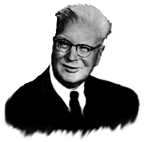Chester Carlson
Necessity is often called "the mother of invention." But sometimes, there are other reasons that people become innovative. For example, the driving force behind an invention can simply be a desire to eliminate tedious tasks by replacing them with more efficient, automated options.
Such was the case of Chester Carlson (1906-1968), inventor of the photocopier. As a young man, Carlson worked as a patent analyzer for an electrical component maker, a job that required him to spend hours going over documents and drawings. It was his job to prepare the paperwork that was submitted to the patent office to register his company's inventions and ideas. However, the patent office required multiple copies which he had to duplicate by hand.
Redrawing the copies took hours. Moreover, Carlson was nearsighted and had arthritis, which made his job even more difficult. He knew there had to be a better way.
Carlson went to work in the kitchen of his home to find a smart alternative. He had an idea for a reproduction technique based on photo-conductivity, in which some materials change their electrical properties when exposed to light. Years of this research led to a patent in 1937 for this process, called electrophotography. However, Carlson's fight wasn't over. It took him another 20 years to find a business interested in his technology. He approached companies like IBM, GE, and RCA, but he was turned away. In 1960, the Haloid company, which later changed its name to Xerox, finally brought Carlson's idea to market.


